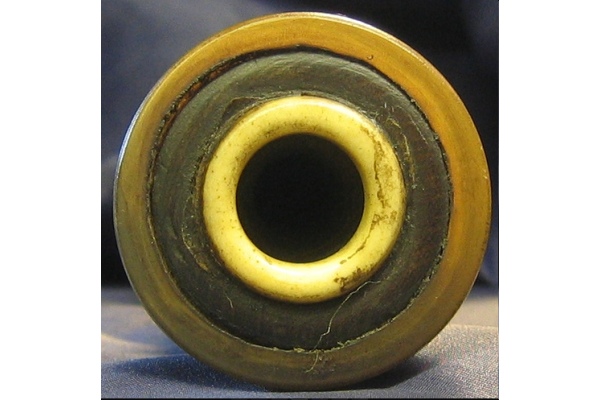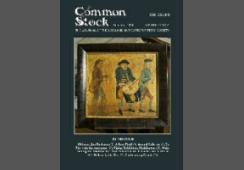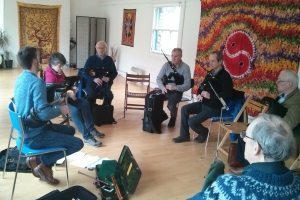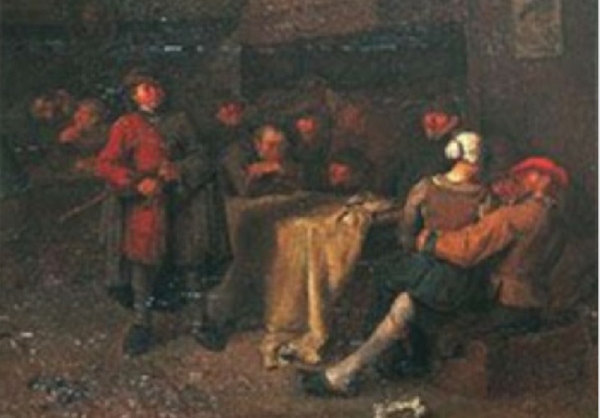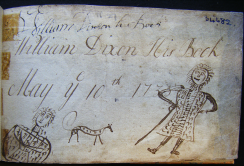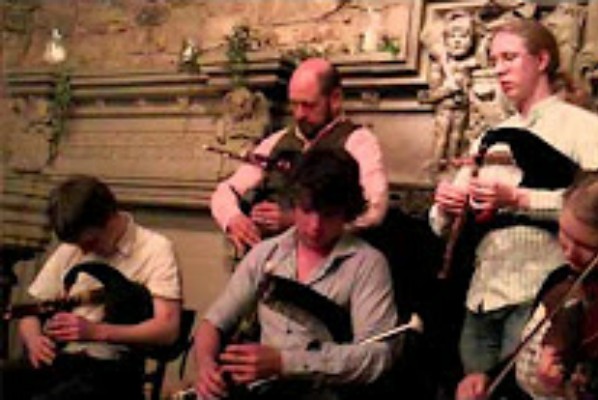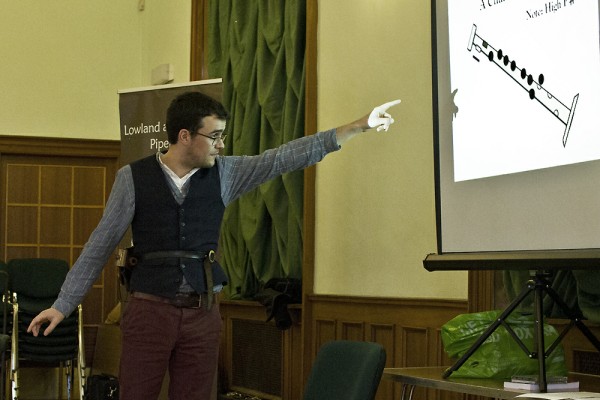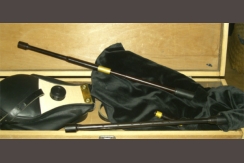


Matt Seattle has written and talked about some of the patterns that emerge when examin- ing traditional Border tunes - in the editorials for The Master Piper and the Border Bagpipe Book, and at the Morpeth meeting (see Common Stock Vol 17 No 2 pp 12-13). Here he sheds further light ...
Harmonic Proportion™ is the name I have given to a group of ideas or principles that have gradually coalesced as I attempted to make sense of Border pipe tunes, particularly those which are usually described as double tonic tunes. It is not a watertight ‘system’ which can be universally applied, but it does have a certain consistency, as well as definite practical uses: understanding the principles can help you both in reconstructing erratically written versions of traditional tunes and in composing new tunes. What you compose according to the principles will sound traditional - though whether it also sounds good depends on differ- ent factors entirely...
We begin in time and space with Piper Ritchie in 18th century Peebles: “the town-piper, dressed in a red uniform and cocked hat, as befitted a civic official ... escorting a marriage- party, he marched with becoming importance in front, playing with might and main a tune called Welcome hame, my Dearie.” (from the Memoir of William and Robert Chambers, 1883 edition).
Even with William Dixon among us once more it is still an exciting business tracking down tunes associated with known Border pipers. There are two strong contenders for Piper Ritchie’s tune, and both are triple-time hornpipes, a type of tune strongly associated with Border piping. The first is called variously Carnagie’s Jig, A Horn Pyp, Jack’s Gone A-Shearing, Jockie’s Gone A Sheering, Nine Nights Away Welcome Hame My Dearie, Welcome Home My Dearie.
I published my own 8 strain set (Jack’s Gone A-Shearing) in The Border Bagpipe Book, but here I’ll stick to the historical record with a nice two strain version from William Vicker’s manuscript. (Vickers’ strain 3 is omitted as it goes beyond the pipe range.
Welcome Home My Dearie [1] (Jack’s Gone A-Shearing, W Vickers 1770)
Notice the chord symbols above the tune. Understanding harmonic proportion relies on hav- ing at least a basic knowledge and understanding of chords and how they relate to melodies. I have met occasional resistance from pipers on mentioning chords, but the evidence from the ‘traditional’ tunes is that the pipers who wrote them understood their chords, whether they gave them the same names as us, or any at all. The move from one chord to the other is clearly experienced when you put half of your attention on the drones and half on the tune - the tune goes ‘in’ and ‘out’ of concord, or harmony, with the drones.
This tune is built on two adjacent chords, A major and G major (the ‘extra’ B minors in strain 2 will be explored below). This is particularly obvious when you compare bars 2 and 4 of each strain - they are the same shape, but one scale degree apart, and closely follow the descending arpeggio of the chord written underneath.
Here we digress slightly to illustrate some important points. Many of William Dixon’s tunes feature an arpeggio strain where the chord sequence is more strikingly defined than in the rest of the tune. Here are two from different tunes.
from Mock The Soldier's Lady (W Dixon 1733)
from The Apprentice Lads of Alnwick (W Dixon 1733)
In both of these the tonic, or rather the ‘modal centre’, is A, concordant with the drones. In- stead of G (the subtonic), the non-drone chord is now B minor (the supertonic). The non- drone chord may also be called the ‘functional dominant’.
Notice that the chords come in different places, but there are the same number of A bars and B minor bars in each tune. What is constant is the proportion, 3:1, just as in our first tune. There is an important distinction between this type of music and many other types of West- ern music, which work on the principle of harmonic direction - starting at, and working to return to, a tonal centre. Here, we are not going anywhere - we have the drones all the time, and we move in and out with them. We may or may not end ‘with’ them, but just because we have drones does not mean that our music is harmonically static in the way that, for example, Indian music is.
Here we return to Piper Ritchie and his other possible wedding tune. It is called Welcome Home My Dearie in one source only, John Rook’s manuscript (1840, Cumbria). His version is nearly identical to Lang Stay’d Away in the Northumbrian Minstrelsy, and it is very possi- ble that the two titles originally ran together as Lang Stay’d Away, Welcome Home My Dearie, very similar to Nine Nights Away Welcome Hame My Dearie in our previous list.
This next list is much longer and drawn from many sources; I am still undecided whether all the tunes with these titles are versions of each other, or close relations, or a mixture, but for now I will simply give the list: Bob And Joan (or Bob And John or Bobbing Joan), Cam Ye O ’er Frae France?, The Cellar Door Key, The French Milliner, Jack Lintel’s Jig, The Key Of The Cellar, Lang Stay Away, Love And Whiskey, Marchioness of Tweeddale’s Delight, Miss Murray’s Reel, The New Way To Morpeth, Pawkie Adam Glen, Welcome Home My Deary.
Welcome Home My Dearie [H] (J Rook 1840)
There are several ideas to explore with the chords here. I have given the simplest possible harmony in order to show how the tune is actually built, rather than how clever the accom- paniment can be. We will take it one strain at a time.
Strain 1. Here you can see the same chords as in The Apprentice Lads of Alnwick, but re- versed. Ignoring the discrepancy in bar 2 for a moment, we still have the 3:1 ratio. The ‘modal centre’ here is B minor rather than A major, so that the A chord, the drone chord, is now the ‘functional dominant’. Now to the discrepancy. The third beat of bar 2 is built on the A chord. With tunes in 3/2 (and 9/4 or 9/8) time we do not divide the bar in half in the middle, but two-thirds of the way through (you’ll have to trust me on this one...). So, taking the first half of the strain, we now have the 3:1 ratio repeated on a smaller scale.
Strain 2. Here we have D major instead of B minor, but not all the time. The ‘fluid tonic’ may be an unusual idea to grasp, but if you know your arpeggios you know that these two chords have two out of three notes in common, so they are not as far away from each other as might first appear.
Strain 3. Here we are back to B minor, but in bars 1 and 3 we have a beat of A major where we didn’t have it before. This can easily be dismissed as a passing chord, but if we look more closely we see that, having divided our 3/2 bar in half two-thirds of the way through, the A comes halfway through the first half-bar, so that within the one bar - if we can accept .
the non-symmetrical division - we have the 3:1 ratio again, this time on a smaller scale still.
This also accounts for the B minors in strain 2 of our first tune mentioned above, B minor being another ‘non-drone’ chord sharing two notes with G major. This repetition of the same ratio on a smaller and smaller scale resembles the fractal patterns behind many natural phenomena. For some, this is evidence of an ordering Intelligence.
These ideas may seem far-fetched, but they make the oft-repeated phrase ‘double tonic’ both simpler and richer than an arbitrary distribution of two chords. 3:1 is not the only har- monic ratio in Border pipe tunes, and not all Border pipe tunes work on harmonic ratios at all, but to give an impression of its importance, 3:1 can be easily discerned in 30 out of William Dixon’s 40 tunes. Which is, almost incredibly, a ratio of 3:1.
Back to Piper Ritchie and which tune he played. The original source of the first tune has a strain which goes beyond the pipe range, as is the case with one or more strains in all other versions found. This shows that it was definitely a fiddle tune, but not that it was definitely not a pipe tune: it is at the very least a pipe-influenced tune, and, in its favour, it is more often associated with the Welcome Hame title than the second tune. In favour of the second tune, it appears more often in pipe-related sources and pipe-friendly settings, and given that Rook’s manuscript, although a mixed bag, does contain Border pipe tunes, it seems the more likely candidate to me.
We explore further in the next issue, Inshallah.
The small print!
For consistency all examples are written in 3/2 and transposed to A chanter range: Vickers’ tune orig in D rather than A, and written with half the note values here (3/4, -orig mistak- enly has 6/8); tunes in Dixon’s manuscript orig one tone lower; Rook’s tune orig one tone lower and written with half the note values here.
